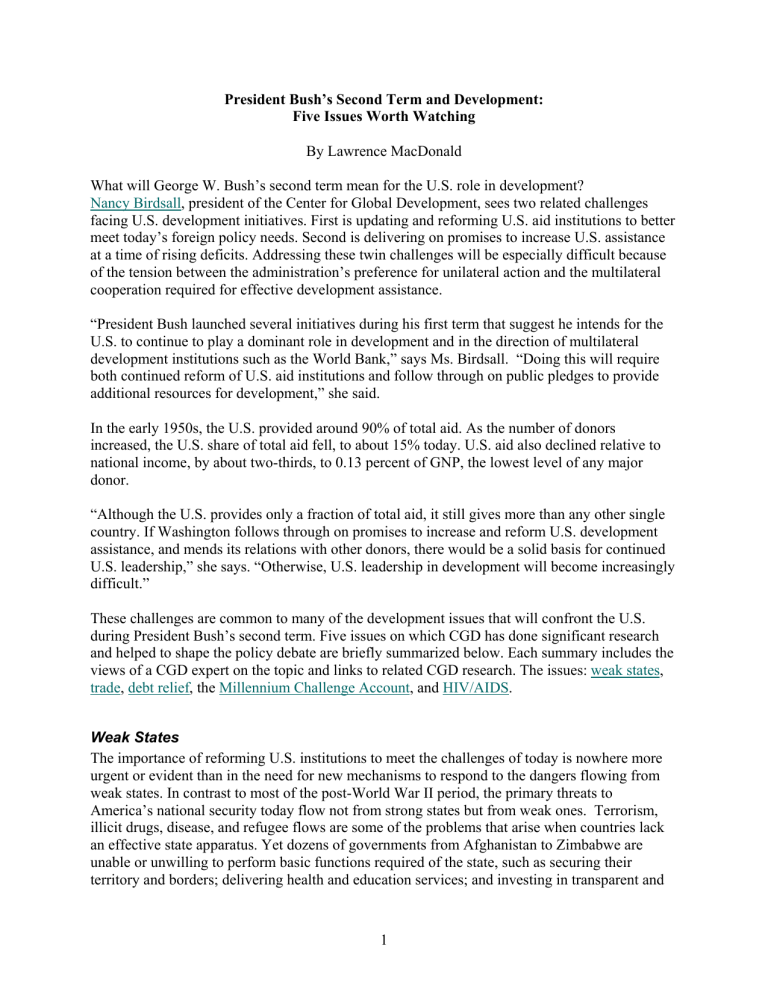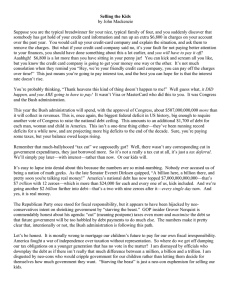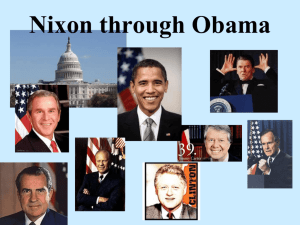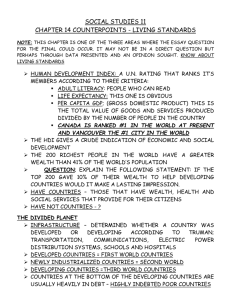President Bush’s Second Term and Development: Five Issues Worth Watching

President Bush’s Second Term and Development:
Five Issues Worth Watching
By Lawrence MacDonald
What will George W. Bush’s second term mean for the U.S. role in development?
Nancy Birdsall , president of the Center for Global Development, sees two related challenges facing U.S. development initiatives. First is updating and reforming U.S. aid institutions to better meet today’s foreign policy needs. Second is delivering on promises to increase U.S. assistance at a time of rising deficits. Addressing these twin challenges will be especially difficult because of the tension between the administration’s preference for unilateral action and the multilateral cooperation required for effective development assistance.
“President Bush launched several initiatives during his first term that suggest he intends for the
U.S. to continue to play a dominant role in development and in the direction of multilateral development institutions such as the World Bank,” says Ms. Birdsall. “Doing this will require both continued reform of U.S. aid institutions and follow through on public pledges to provide additional resources for development,” she said.
In the early 1950s, the U.S. provided around 90% of total aid. As the number of donors increased, the U.S. share of total aid fell, to about 15% today. U.S. aid also declined relative to national income, by about two-thirds, to 0.13 percent of GNP, the lowest level of any major donor.
“Although the U.S. provides only a fraction of total aid, it still gives more than any other single country. If Washington follows through on promises to increase and reform U.S. development assistance, and mends its relations with other donors, there would be a solid basis for continued
U.S. leadership,” she says. “Otherwise, U.S. leadership in development will become increasingly difficult.”
These challenges are common to many of the development issues that will confront the U.S. during President Bush’s second term. Five issues on which CGD has done significant research and helped to shape the policy debate are briefly summarized below. Each summary includes the views of a CGD expert on the topic and links to related CGD research. The issues: weak states , trade , debt relief , the Millennium Challenge Account , and HIV/AIDS .
Weak States
The importance of reforming U.S. institutions to meet the challenges of today is nowhere more urgent or evident than in the need for new mechanisms to respond to the dangers flowing from weak states. In contrast to most of the post-World War II period, the primary threats to
America’s national security today flow not from strong states but from weak ones. Terrorism, illicit drugs, disease, and refugee flows are some of the problems that arise when countries lack an effective state apparatus. Yet dozens of governments from Afghanistan to Zimbabwe are unable or unwilling to perform basic functions required of the state, such as securing their territory and borders; delivering health and education services; and investing in transparent and
1
accountable institutions. Without an effective U.S. response, the problems that arise in states that are weak or have collapsed can pose a serious threat to U.S. interests.
The 2002 National Security Strategy, authored by the Bush Administration, acknowledged this new threat when it stated that “The events of September 11, 2001, taught us that weak states, like
Afghanistan, can pose as great a danger to our national interests as strong states.”
Administration lacks a comprehensive strategy to reverse state weakness and combat state failure, it has taken steps to tackle the weak states threat.
First, it has created a 25-person Office of Reconstruction and Stabilization at the State
Department, tasked with coordinating U.S. civilian responses to failed states.
proposed the creation of a $100 million complex contingency fund that would allow rapid assistance to flow to crisis situations at the behest of the Secretary of State. But the House version of the 2005 Foreign Operations appropriations bill made no provision for the new fund; and the Senate allocated only $20 million. Indeed the 2005 omnibus appropriations bill remained silent on the complex contingency fund, allocating no money to the fund at this time. More encouragingly, the U.S. was instrumental in brokering a G-8 plan to train 75,000 new peacekeepers in Africa and elsewhere by 2010.
Because the challenge of weak states is the area where development needs and U.S. security concerns coincide most clearly, the political drive for effective U.S. action on this issue may be greater here than on any other development issue. Yet the problems are also more difficult and complex.
“Addressing the crisis of poor governance across the developing world is a major challenge facing the Bush Administration in its second term,” says Jeremy Weinstein , lead author of On the Brink: Weak States and U.S. National Security , and a CGD Non-Resident Fellow .
“From Nigeria, where instability threatens global energy supplies, to Indonesia, where terrorist networks are finding fertile ground, the U.S. has an important role to play in supporting transparent and effective governance before conflict erupts,” he says. “Our continued presence in
Iraq and the fiscal constraints we face at home make building an agenda around preventive action difficult, but not impossible.” As with other U.S. development challenges, he says “the key is presidential leadership.”
Trade Policy
U.S. agricultural subsidies and protectionist measures that limit developing countries’ access to the vast U.S. market are serious impediments to growth and poverty reduction in poor countries.
1
Commission on Weak States and U.S. National Security, On the Brink: Weak States and U.S. National Security,
2
Sponsored by the Center for Global Development, June 2004.
The White House, The National Security Strategy of the United States of America, September 2002.
3
See Office of the Coordinator for Reconstruction and Stabilization, http://www.state.gov/s/crs/ .
4
Group of Eight, “G-8 Action Plan: Expanding Global Capability for Peace Support Operations,” available at http://www.g8usa.gov/pdfs/0610ActionPlanPeaceOperations.pdf
.
2
The president’s record on these issues during his first term was mixed. Improvements will require that development concerns—and the costs to the U.S. of the problems that flow from failed development—are more fully taken into account in formulating trade policy.
On the pro-development side of the ledger, President Bush pursued several bilateral and regional trade agreements that increased access to U.S. markets. The Administration negotiated bilateral agreements with Chile, Morocco, Australia, and Singapore, and the regional Central American
Free Trade Agreement (CAFTA), which includes Costa Rica, Dominican Republic, El Salvador,
Guatemala, Honduras, and Nicaragua . The president also made possible continued preferential market access for some of the poorest African countries by signing legislation that extended the
Africa Growth and Opportunity Act (AGOA) through 2015. And the Administration continues to work toward a broader Free Trade Area of the Americas, which would unite the economies of the Americas in a single free trade zone.
But the outlook for reductions in U.S. agricultural subsidies was less encouraging. The
Administration did reach a tentative agreement with the EU to eliminate agricultural export subsidies in the context of the Doha Development Round of World Trade Organization (WTO) trade negotiations. But production subsidies, which can artificially boost U.S. output, thereby undercutting developing countries’ own export opportunities, remain largely untouched. Indeed,
President Bush signed into law the 2002 Farm Bill, which provided an average of $15 billion annually in agricultural subsidies during 2002-04, two-thirds of which went to the largest 10 percent of farms.
The tension between trade liberalization and domestic politics was similarly evident in March
2002, when the president imposed steel tariffs to protect U.S. producers. The tariffs were dropped when the WTO determined that they violated international trade rules, opening the prospect of retaliation against other U.S. exports.
William Cline , a CGD Senior Fellow and the author of Trade Policy and Global Poverty , sees progress in the WTO’s Doha Development Round negotiations as central to the Administration’s contributions to development. “The most important thing the second Bush administration can do for developing countries is to achieve deep reductions in trade barriers through the Doha Round negotiations,” he says. “These should especially include sharp cuts in high tariffs and in agricultural subsidies."
Debt Relief
In the late 1990s donors launched the Heavily Indebted Poor Countries (HIPC) initiative, jointly administered by the World Bank and International Monetary Fund (IMF), to relieve the external debt of the most severely indebted poor countries. HIPC has cut the debt of the 27 countries receiving assistance through the program by two-thirds.
Yet problems persist: many HIPC
countries remain vulnerable to adverse, unpredictable external shocks such as the sudden
5
International Monetary Fund and International Development Association, Heavily Indebted Poor Countries (HIPC)
Initiative: Status of Implementation, Prepared by the Staffs of the IMF and World Bank, August 20, 2004, available at: http://siteresources.worldbank.org/INTDEBTDEPT/PublicationsAndReports/20264190/HIPC-status-Of-
Implem.pdf
.
3
collapse of commodity prices or natural disasters. Despite donor promises, several HIPC countries still struggle with unsustainable debt burdens.
At the 2004 World Bank/IMF Fall Meetings, the Bush administration floated the idea of 100% debt cancellation for countries receiving HIPC assistance.
provide new money, however, the White House proposed that the relief be funded by drawing down World Bank and IMF reserves. The suggestion was linked to similar debt relief for Iraq.
The implied deal—U.S. agreement on 100% debt forgiveness for the HIPC countries if creditors also canceled Iraq’s debt—attracted little support from other donors. Some expressed concern that the proposed financing mechanism could undermine the long-term viability of the World
Bank and the IMF. A new agreement by the so-called Paris Club to cancel $31 billion of Iraq’s
$38.9 billion debt covers bilateral debts but not the money owed to the multilateral organizations.
Whether there will be further U.S. leadership efforts on debt relief is unclear.
“As with many development-related initiatives, the outlook for increased U.S. assistance for debt relief is clouded by the rising U.S. deficit and competition for resources from domestic programs and the war in Iraq,” says Ms. Birdsall, who has written extensively on aid and debt. “But without additional resources from the U.S., it’s hard to see how U.S.-proposed initiatives for
100% debt relief can get off the ground.”
The Millennium Challenge Account
During his first term, President Bush announced two major increases in development assistance: the Millennium Challenge Account (MCA), designed to increase core development assistance to high-performing countries by $5 billion a year; and an emergency plan for HIV/AIDS (discussed separately below).
According to CGD Senior Fellow Steven Radelet , the MCA has the potential to bring about the most fundamental change to U.S. foreign assistance policy since President John F. Kennedy introduced the Peace Corps and the U.S. Agency for International Development (USAID) in the early 1960s.
The significance lies partly in its scale: the proposed $5 billion annual budget
would represent a 50% increase over recent annual aid allocations and a near doubling in the amount that focuses strictly on development objectives. Even if the MCA never reaches the full
$5 billion the President promised, it still will likely be of significant size.
More importantly, the guiding principles of the MCA—providing significant increases in assistance to poor countries that rule justly, invest in their people, and encourage economic freedom—could improve the allocation and delivery of U.S. assistance. It could also strengthen incentives for developing countries to tackle tough problems that hinder growth and poverty reduction, such as corruption. “Overall the MCA is worthy of support,” Mr. Radelet said in
6
See Nancy Birdsall and John Williamson, with Brian Deese, Delivering on Debt Relief: From IMF Gold to a New
Aid Architecture (Washington: CGD/IIE, 2002).
7
U.S. Department of Treasury, “Secretary Snow Development Committee Statement for the Record,” October 2,
8
2004, available at http://www.treasury.gov/press/releases/js1987.htm
.
The Millennium Challenge Account; Testimony for the House International Relations Committee, March 6, 2003
4
Congressional testimony last year. “It builds on America’s core values of generosity, commitment to progress, and the expectation of clear results.”
However, the MCA has proceeded much more slowly than the original announcement indicated.
More than 2½ years after the President proposed the initiative, the MCC has not concluded negotiations with any countries nor disbursed any financing. Moreover, funding for the programs is lower than expected. The White House originally suggested that it would seek over
$3 billion for the second year of the program, but it only requested $2.5 billion, and the recentlypassed 2004 omnibus appropriations bill allocates only $1.5 billion to the MCA.
In addition, the selection of countries qualified to participate in the MCA has been less straightforward than originally envisioned. The Millennium Challenge Corp. (MCC), created to oversee distribution of the money according to the new, transparent criteria, has accepted some countries that fall short of the standards while rejecting others that pass the tests. Moreover, many questions about implementation of the program remain unanswered, including precisely what kinds of activities the MCC might fund, how service delivery will be contracted, and how progress will be monitored and evaluated.
“The president’s plan to reward good performers with substantial increases in aid makes sense,” says Mr. Radelet. “But for that to work, the standards that recipient countries are being asked to meet must be clear, and the rewards must be worthwhile and assured. It remains to be seen whether the promise of the MCA can be turned into reality.”
“Beyond the MCA our aid programs remain weak and fragmented. As with the reorganization of homeland security and intelligence services, a major challenge for a second administration will be to provide the vision, rationale, and organization to strengthen all of our foreign aid programs to better meet our foreign policy objectives in the 21 st
century,” he says.
HIV/AIDS
In his January 2003 State of the Union Address, President Bush announced the President’s
Emergency Plan for AIDS Relief, (PEPFAR) a five-year, $15 billion initiative “to turn the tide against AIDS in the most afflicted nations of Africa and the Caribbean.” The $15 billion consists of $5 billion in pre-existing programs, $1 billion for the global Fund for AIDS,
Tuberculosis, and Malaria, and $9 billion of new money for intensive programs in 15 countries.
To oversee the implementation of this plan, which the president described as “a work of mercy beyond all current international efforts to help the people of Africa,” the Administration created the Office of the U.S. Global AIDS Coordinator at the State Department, headed by Ambassador
The President requested $1.45 billion for this program for FY2005, but it was
recently funded by Congress at $1.385 billion.
As with the MCA, as important as the amounts is whether arrangements are in place for the funds to be used effectively. President Bush supported legislative requirements that stipulate that at least a third of PEPFAR's prevention funds be used for "abstinence-only" programs.
Moreover, PEPFAR allocations compete with contributions to multilateral initiatives,
9
See Office of the U.S. Global AIDS Coordinator, http://www.state.gov/s/gac/ .
5
particularly the Global Fund to Fight AIDS, TB and Malaria. The Administration has proposed cutting funding for the Global Fund from $547 million in FY04 to $200 million in FY05. The funding levels were partially restored by Congress; the recently-passed 2005 omnibus appropriations bill allocates $437.8 million to the Global Fund.
Ruth Levine , a CGD Senior Fellow and the lead author of Millions Saved: Proven Successes in
Global Health , says that the biggest HIV-related challenge for the Bush administration will be ensuring that U.S. funds have a genuine and lasting impact on the course of the epidemic. “The jury is out on whether PEPFAR is going to be able to do what the most successful global health programs have done in the past—bring together good science, effective management and an understanding of how to make things work in poor countries,” she says.
“PEPFAR has a lot to prove. Right now, it is widely seen as the Administration's effort to push prevention and treatment approaches that are not widely accepted as optimal by international
AIDS experts,” she says. “Over the next year, the president’s decisions about how to put
PEPFAR into action and how to support multilateral initiatives will determine the success of the president’s ambitious promises.”
6








